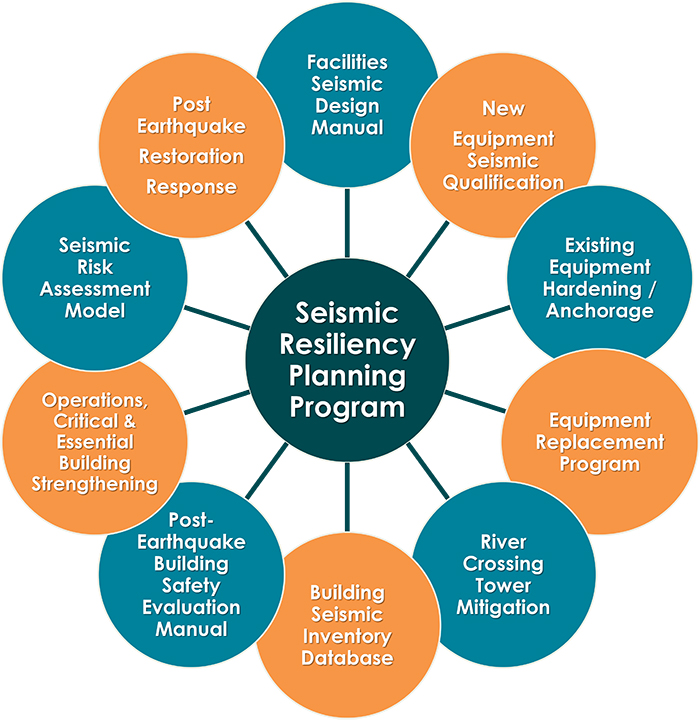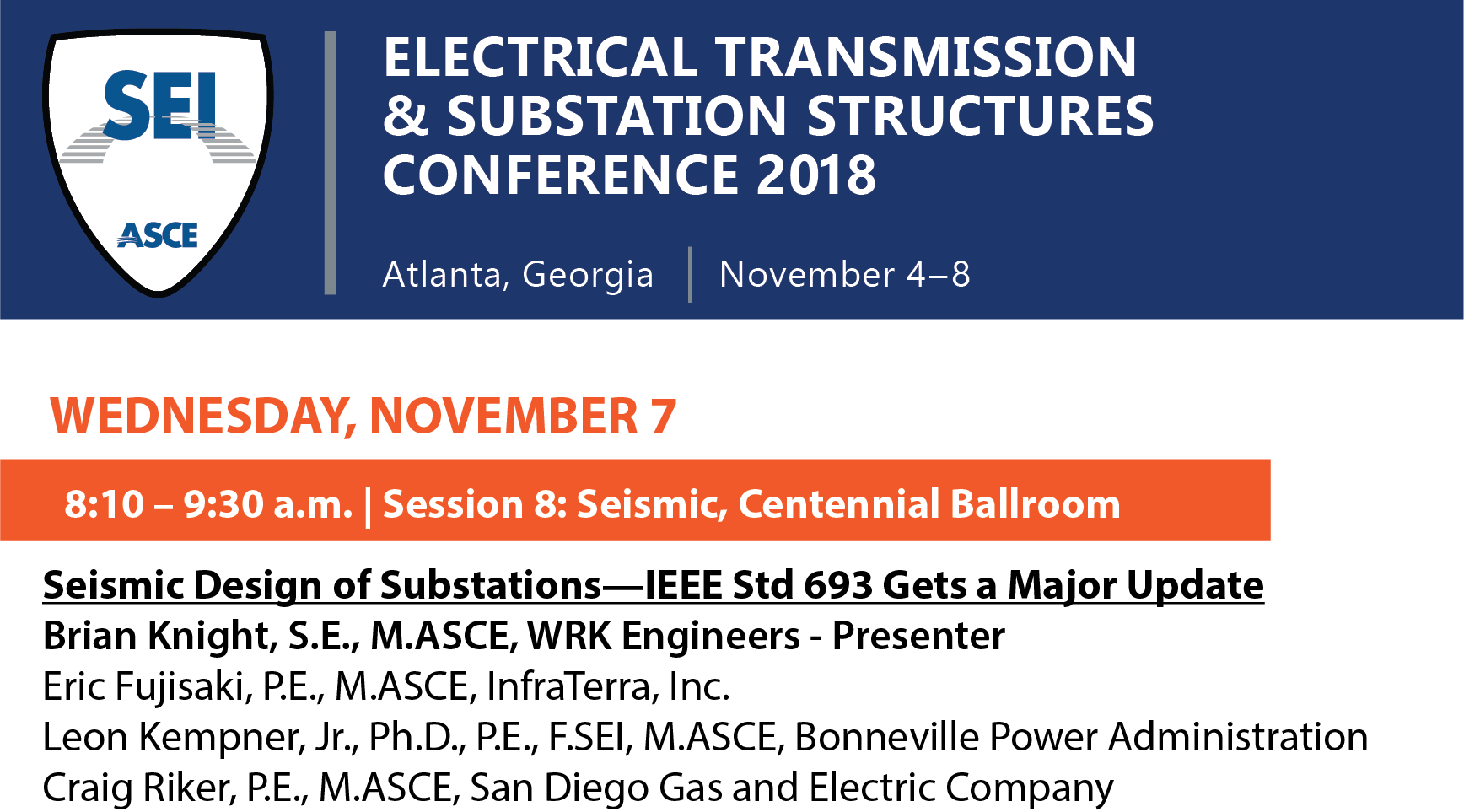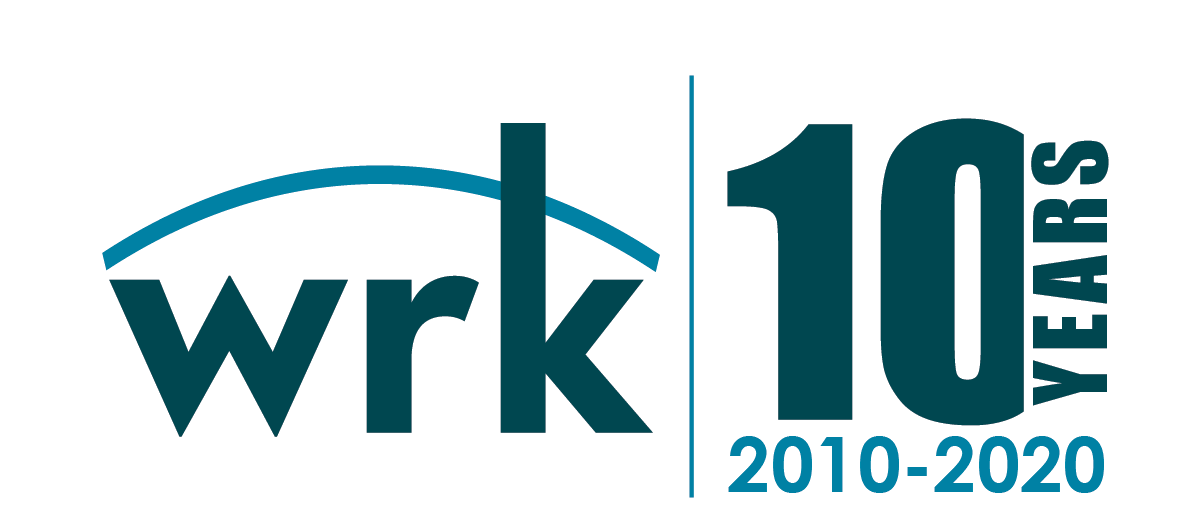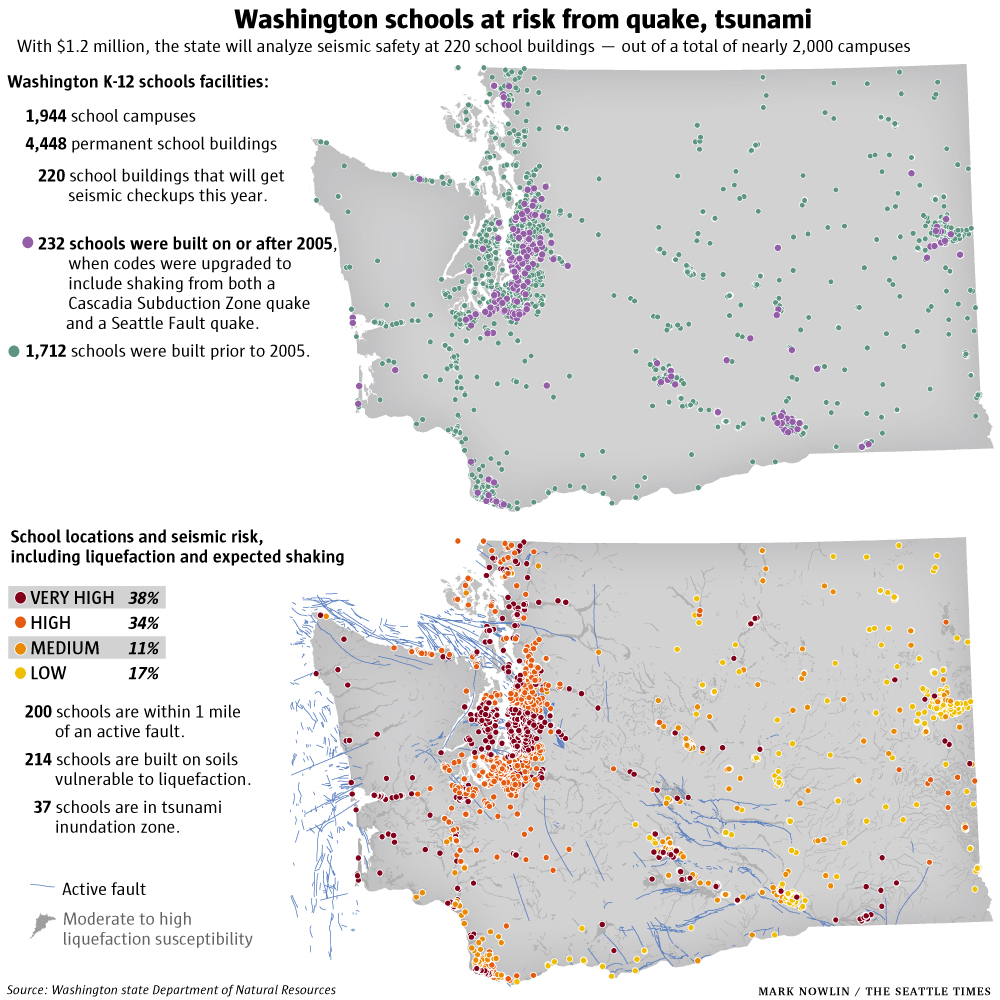You need to keep your mission-critical facilities to zero downtime. We can help.
WRK provides comprehensive Seismic Resiliency Planning Programs to protect your full inventory of physical assets and to prepare immediate backup and recovery plans. WRK has led teams on a multitude of seismic strengthening and earthquake engineering related projects for public and private utility clients and multi-national corporations.
An effective Seismic Resiliency Planning Program will address the need for reduction of outages when restoration of water and electric services is critical to post-earthquake response and recovery for industrial, commercial and residential customers.

Components of a successful Seismic Resiliency Planning Program include:
- Seismic evaluation of all existing facilities, substations, transformers and other equipment within the agency
- Strengthening of existing structures
- Seismic hardening (anchorage) of necessary equipment
- Post-Earthquake Building Safety Evaluation training for staff and personnel
- Development of a Building Seismic Inventory Database within which to prioritize the timing of upgrades
- Creation of a Seismic Design Manual for all new and existing buildings and equipment
Brian Knight, SE presenting at ETS ’18
Our very own President and Founder, Brian Knight, is presenting this week at the Electrical Transmission & Substation Structures Conference in Atlanta, GA. He’ll be presenting a group paper on the Seismic Design of Substations – IEEE Std 693 Gets a Major Update. Brian was fortunate to be able to co-author this paper with three highly respected members of the engineering community. Eric Fujisaki, P.E., Leon Kempner Jr. PhD., P.E, and Craig Riker, P.E.

 Brian received his Bachelor’s Degree in Civil Engineering from the University of Washington and a Master’s Degree in Structural Engineering from the University of Illinois at Urbana-Champaign. His 20+ year professional career has focused on earthquake performance and resiliency of critical infrastructure, especially in the area of power and transmission infrastructure performance. Brian is a highly valued consultant providing his seismic expertise to Power Utilities, High-Voltage Equipment Manufacturers, EPC contractors. Brian’s experience includes seismic qualification of equipment, substation vulnerability assessment, seismic strengthening of buildings and power system seismic risk assessment, and the design of new substation structures and foundations. This unique cross section of experience gives him valuable insight into the holistic needs of every project he is engaged in. Brian’s professional commitment to advance the state-of-the-practice for earthquake engineering in the electric power industry is demonstrated by his involvement in numerous national committees including IEEE Std. 693 (Recommended Practice for Design of Substations), IEEE Std. 1527 (Design of Flexible Buswork Located in Seismically Active Areas) and ASCE 113 (Substation Structure Design Guide). Brian has served for the past 8 years as the Secretary for the IEEE Std. 693 Committee.
Brian received his Bachelor’s Degree in Civil Engineering from the University of Washington and a Master’s Degree in Structural Engineering from the University of Illinois at Urbana-Champaign. His 20+ year professional career has focused on earthquake performance and resiliency of critical infrastructure, especially in the area of power and transmission infrastructure performance. Brian is a highly valued consultant providing his seismic expertise to Power Utilities, High-Voltage Equipment Manufacturers, EPC contractors. Brian’s experience includes seismic qualification of equipment, substation vulnerability assessment, seismic strengthening of buildings and power system seismic risk assessment, and the design of new substation structures and foundations. This unique cross section of experience gives him valuable insight into the holistic needs of every project he is engaged in. Brian’s professional commitment to advance the state-of-the-practice for earthquake engineering in the electric power industry is demonstrated by his involvement in numerous national committees including IEEE Std. 693 (Recommended Practice for Design of Substations), IEEE Std. 1527 (Design of Flexible Buswork Located in Seismically Active Areas) and ASCE 113 (Substation Structure Design Guide). Brian has served for the past 8 years as the Secretary for the IEEE Std. 693 Committee.
DNR School Seismic Safety Assessment Project
![]() Washington State Department of Natural Resources (DNR) has begun taking steps to assess the seismic safety of many of Washington’s K-12 schools. Washington has a high risk of damaging earthquakes which makes it essential to establish seismic safety of schools throughout the state, especially when considering a Cascadia subduction zone event aka “The Big One.” More than 72 percent of schools are located in a high to very high seismic hazard zone
Washington State Department of Natural Resources (DNR) has begun taking steps to assess the seismic safety of many of Washington’s K-12 schools. Washington has a high risk of damaging earthquakes which makes it essential to establish seismic safety of schools throughout the state, especially when considering a Cascadia subduction zone event aka “The Big One.” More than 72 percent of schools are located in a high to very high seismic hazard zone
DNR recently received funding to work with the Office of Superintendent of Public Instruction and we are part of a team of structural engineers to conduct seismic assessments at approximately 220 school buildings in the state. Conceptual seismic retrofit plans will be produced for 20 of the school buildings deemed most at risk. The project will also prioritize the remaining schools that are seismically deficient and help identify additional funding sources for seismic retrofit. WRK Engineers is assigned ~60 of these schools and 2 fire stations for the project. This effort is led by Reid Middleton, Inc and also supported by BergerAbam, DCI Engineers, Dykeman Architects, Rolluda Architects, and ProDims.
High Voltage Substation Seismic Anchorage
Nevada
Designed seismic retrofit anchorage of existing high voltage substation equipment for over 70 NV Transformers throughout their service territory. This highly specialized work included extensive field investigation time in order to capture the in service condition. All anchorage designs called for installation and construction activities to occur while the substations remained fully-energized. Knowledge of the substation environment and operation aspects of the effected equipment is essential for successful completion of this work.
Power Generations Station, Seismic Risk Assessment
Greater Los Angeles, California
Served as part of team that provided preliminary seismic risk assessment for three power generation stations in the Greater Los Angeles, California area. Power stations at Huntington Beach, Los Alamitos and Redondo Beach were included in the Seismic Risk Assessment. Project included site walk-down at each station and identification of likely seismic deficiencies which would affect power generation operations during a major seismic event. Provided recommendations for addressing identified seismic hazards.
System Earthquake Risk Assessment (SERA)
Washington, Oregon, Idaho, Montana & California
Worked with BPA to collect field data and provide computer input for nearly 130 substations across the BPA transmission system grid. The computer program SERA is used to identify seismic hazards on a system wide basis by utilizing estimated fragility values to calculate expected damage levels of substation equipment when subjected to scenario earthquake simulations.
Seismic Building Mitigation Program
Various Locations
Serving as prime consultant for BPA, led a multidisciplinary design team to provide building seismic evaluation and develop seismic strengthening construction documents for 38 mission critical buildings including a Control House all in the BPA system. The design team, which included architects, mechanical engineers, electrical engineers, cost estimators & hazardous materials consultants, was assembled to address identified seismic vulnerabilities for both structural and non-structural building systems. All strengthening measures considered the highly-sensitive building functions and allowed for construction activities to occur during continuous, 24-hour operations of the Control House. These buildings were strengthened to provide Immediate Occupancy Performance following a major seismic event.
Post-Earthquake Building Inspection Program
Various Locations
Developed training to equip first responders with necessary skills and tools to quickly identify and assess hazardous conditions in BPA’s mission critical facilities following an earthquake. Utilizing ATC-20 procedures, modified for BPA specific criteria, along with the modified ATC-20 Program, BPA personnel are trained using customized REVIT models, a field guide with evaluation worksheets design for use on all building types within the system. Training Includes initial classroom training on earthquake basics, fundamentals of damage assessment and detailed analysis of BPA specific buildings.
Substation Switch House and Yard, Seismic Evaluations
Tennessee and Alabama
Developed conceptual seismic strengthening for switch house buildings in the TVA system. All strengthening measures are considerate of the highly sensitive building functions and must allow for construction activities to occur during continuous, 24-hour operations of the switch house. These buildings were evaluated for Immediate Occupancy Performance following a major seismic event.
Seismic Inventory Database (SID)
Portland, Oregon
Worked with BPA to develop a Seismic Inventory Database (SID) to identify potential seismically vulnerable building assets within the BPA system. The SID will be used to prioritize vulnerable buildings based on ASCE-31 Common Building Type, geographic seismic hazard, total building area and BPA function priority (i.e. “mission critical” or “non-mission critical”). The SID is being used by BPA to develop a priority ranking system that will serve as a road map for future selection and mitigation of seismically vulnerable building assets.
"It is good to have a resource with experience to help establish a proper and accurate analysis of the equipment so as to limit cost by getting the design right the first time… WRK is not simply asking us what we want them to do, but they are trying to understand what we want to do, and then use their experience to determine the best way to get there."
Wesley Wills, Southern States LLC.
"The benefit of working with WRK is that they are creative. I work with many engineers that are very conservative–they prefer to stick to standard details. WRK brings innovative solutions and enjoys the challenge of using new technologies that might be less costly and easier to construct. Brian was trained to be innovative, and his firm operates the same way."
Jeff McGraw, MWA Architects
"What separates WRK from other firms is a working, hands-on, experience based knowledge. They’re not just theory based. Everyone, including construction crews, is impressed with WRK’s response time. When we had a question or minor changes, they responded within hours. My experience with WRK has been nothing but good."
Casey Scoggins, Tennessee Valley Authority
"I trust WRK. It isn’t about being the biggest firm, it is about getting the work done correctly."
Matt Weisensee, PacifiCorp
"WRK consistently provides creative solutions for highly sensitive projects. Approaching each project as if it is unique is highly valuable."
Casey Wyckoff, LSW Architects
"The WRK team is easy to work with, knowledgeable, and they have the credentials. They are approachable, they listen, respond and do what they can to meet our needs without argument. Over many years their work has been consistent, always learning and adapting."
Leon Kempner, Bonneville Power Administration
"I value WRK’s nuts-and-bolts approach with their ability to communicate in the field and provide constructable solutions. Historic projects can be convoluted, which can cause structural engineers to jump through hoops. This can be difficult for many engineers, but not WRK. They are great at considering and explaining all of the options with the understanding that structural isn’t driving the design."
Eric Philps, SERA Architects

